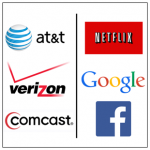 What is Net Neutrality?
What is Net Neutrality?
The idea behind net neutrality is that Internet service providers (ISPs) should treat all Internet traffic equally and not create disadvantages for specific websites and web services, or “fast lanes” for others. In theory, this should stop companies like Comcast, Verizon, and AT&T from charging companies like Netflix or Google for better speed and service on the infrastructure they’ve built. In practice, things are currently a bit more complicated.
A Brief History
The short version is that various rulings by the Federal Communications Commission (FCC), which has broad oversight of the communications industry, have long dictated that ISPs needed to provide a level playing field for their customers. In 1996, Congress overhauled telecommunications law, breaking down communications services into two categories: telecommunications services (think traditional landline phone service), and information services (think Facebook), creating significant debate over how to classify ISPs. In 2005, the Supreme Court ruled that the Federal Communications Commission (FCC) could classify ISPs as information services, which industry lobbyists, among others, strongly encouraged them to do. So they did.
Earlier this year, an appeals court ruled that if in fact ISPs are information services rather than telecommunications services, then the FCC can’t impose net neutrality rules on them. This caused the FCC go back to the drawing board to generate a new set ofproposed rules, which were then opened for public comment. The public responded with more than 3.7 million comments.
What’s at Stake?
Without overstating things, the very idea of an Open Internet that provides equal access to all websites and services could be at stake.
Advocates of net neutrality point to recent deals like the one between Netflix and two ISPs (Comcast and Verizon) that provides improved speeds on their networks in exchange for payments from Netflix. Without net neutrality rules in effect, these so called paid prioritization deals could proliferate. Critics argue that paid prioritization will be a severe detriment to startups and innovators that don’t have the money to pay ISPs for preferred service in order to reach potential customers.
Additionally, without rules for net neutrality, it is conceivable that ISPs could deliberately reduce speeds for services that represent a competitive threat. For example, a telephone company (like Verizon) could diminish speeds of an Internet calling service (like Skype) because it competes with their own telephone service offerings.
Those in favor of net neutrality rules seem to represent a strong majority, comprised of both web content producers and the general public. Of those 3.7 million comments submitted to the FCC, almost all were in favor of net neutrality. In addition to overwhelming public support, most higher education consortia are firmly behind net neutrality.
On the flipside, critics of net neutrality argue that new rules would discourage ISPs from innovating and building costly new infrastructure, and that the simple act of crafting effective, long-term rules for a rapidly changing online landscape would be all but impossible.
What’s next?
The FCC is continuing to discuss the proposed rules and a decision is expected sometime next year. In addition, rules for wireless access have come to the forefront of the debate and the FCC looks to be on the cusp of removing classic distinctions between wired and wireless access to the Internet. Regardless of the new rules that eventually take effect, there surely will be ongoing debate, lawsuits, and uncertainty over how we view and regulate the Internet moving forward. While much of the discussion revolves around dense technical and legal issues, the underlying ideas and potential outcomes should be of interest to everyone who uses the Internet, which is just about everyone.
Additional Resources
Everything you need to know about network neutrality (Vox)
New York Times net neutrality coverage